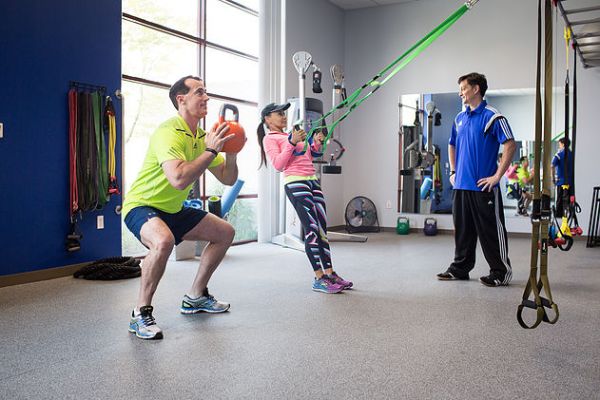In theory, making the move from a single sport to three adds variety to your exercise regimen and will reduce injuries, right?
Well, the reality is a bit different, thanks to the “compound effect” of doing three activities: “What we have to compare it to other sports is the injury rate, and triathletes have one of the highest incidence rates of any sport,” Dr. Joshua Burns, a researcher and podiatrist at the University of Sydney in Australia, who has studied the nature of triathletes’ injuries told The New York Times in this article.
The bad news? Triathletes, in particular, are susceptible because they not only engage in a highly-repetitive stress activity, but also only move in one plane of motion (and likely sit all day at work), which contributes to limited range of motion in the mid-back and hips. The good news, though? With the right approach to strength training, you can correct imbalances, resolve weaknesses and vastly improve performance.
That’s where my friend Al Painter of INTEGRATE Performance Fitness comes in. Not only has he been teaching endurance athletes how to dodge the injury bullet for years, but he also knows. his. stuff. As you can see below, there’s a reason why he’s been named “Best Bay Area Personal Trainer” by CitySports Magazine, so I always love picking his brain about the latest workout crazes and geeking out together over the greatest fitness gadgets.
As training seasons begin to ramp up, I thought it’d be fun to sit down with him and talk about the not-so-secret secret for avoiding injury when it comes to multi-sport endeavors.
1. Triathlon is in endurance sport, so why is strength training important for triathletes? It helps to reset the body from the repetitive stress nature of training in one plane of motion. It can also keep the hips strong, which goes a long way for happy low backs and knees.
2. How much about it is preventing injury versus being able to perform better (i.e. faster!)? Yes to both! I think one leads to the other. Keep the muscles balanced, and you can reduce your chances of getting hurt and improve your chances of performing well.
3. If body weight is the only thing being “lifted” during a triathlon, why do triathletes need a training program that uses free weights, machines or other equipment? It can lead to more speed in the pool, more power on the bike and more efficiency running.
4. How does strength training for triathletes differ from programs used by bodybuilders, powerlifters and the general public? Triathlon training should emphasize split-stance and single-leg lower body moves while incorporating single and alternate arm patterns to work on diagonal loading of the hips and shoulders working through the core. I’ll definitely get into more of what endurance athlete specific strength training should like the night of the talk.
5. What do you think is the biggest misconception about triathletes and strength training? That it will slow them down, add bulk and take away from swimming, riding and running.
6. So is it enough to go lift weights at the gym a few times a week? No, there needs to be a program dialed in to address what endurance athletes need: solid mid-back, shoulder and hip mobility. It has to have a plan, a purpose and specific outcome as the goal. Plus, if there is a performance gap in the pool, on the bike or on the run, strength training can help to close it.
7. What’s the biggest mistake you see most triathletes make with their current strength training routine? Not enough emphasis on the back half of the body which is the powerhouse for performance and proper posture.
8. If there’s one exercise triathletes absolutely cannot afford to skip, what is it? I don’t know if it’s an exercise as much as it is a movement: Learning the hip hinge is critical to opening the front half of the body and strengthening the back half to help with both injury prevention and performance improvement.
9. Should triathletes adjust their program when training for different distances? How? My stance on this is that the longer the distance, the more hip dominant movements (hinges, bridges, etc.) they should do. It should be the majority of the lower body work to keep the glutes as “online” as possible. Once they shut down, the whole operation can go south.
10. Say someone’s deep into training and short on time; is there a minimum amount of strength training they should be doing each week? Two days a week for at least 30 minutes using compound movements. Exercises combining hinging + pulling and squatting + pressing work really well. Especially using a split stance with single or alternate arm exercises.
Thanks, Al — great info, as always!
Attention Bay Area friends: Al’s doing a *free* triathlete-specific strength training workshop at Sunnyvale Sports Basement from 6:30-8:00 p.m. on Thursday, February 11. Swing by, say hi, and pick up some of his tips on the best kinds of strength training exercises to help you race stronger, recover faster and reduce the chance of getting injured this season.
Click here for details on the event, and visit INTEGRATE Performance Fitness to learn more.


Strength work is always a part of my routine! I can’t imagine not incorporating it in! I’m bummed that I won’t be in the Bay Area to here him. Does he have podcasts? Videos? I’m always looking for new moves to improve my strength training!
LikeLike
Yes! I spoke to him about this & I believe he’s going to reply with some info…
LikeLiked by 1 person
Sweet! Thank you!
LikeLike
See below!
LikeLiked by 1 person
Kecia,
Thanks a ton for reading the post! If you’d like more training info, drop me a line and I’d be more than happy to help!
Al
LikeLiked by 1 person